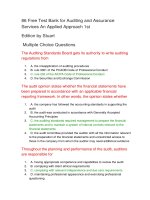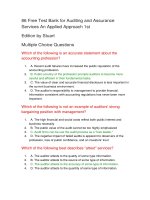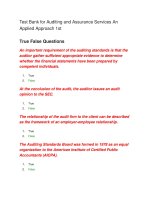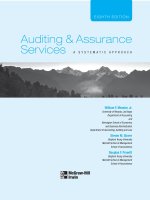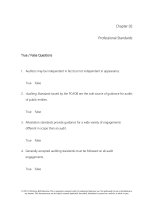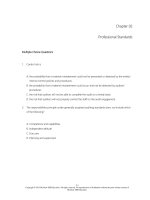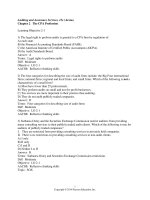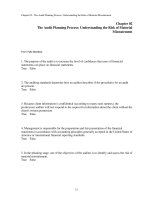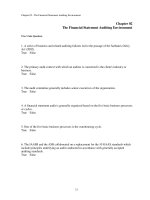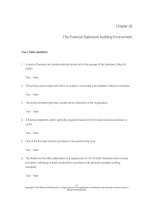Auditing and assurance services a systematic approach 8e glover prawitt
Bạn đang xem bản rút gọn của tài liệu. Xem và tải ngay bản đầy đủ của tài liệu tại đây (27 MB, 32 trang )
Confirming Pages
EIGHTH EDITION
Auditing & Assurance
Services
A
S Y S T E M A T I C
A P P R O A C H
William F. Messier, Jr.
University of Nevada, Las Vegas
Department of Accounting
and
Norwegian School of Economics
and Business Administration
Department of Accounting, Auditing and Law
Steven M. Glover
Brigham Young University
Marriott School of Management
School of Accountancy
Douglas F. Prawitt
Brigham Young University
Marriott School of Management
School of Accountancy
mes25435_fm_i-xxxii.indd i
22/07/11 2:52 PM
Confirming Pages
AUDITING AND ASSURANCE SERVICES: A SYSTEMATIC APPROACH
Published by McGraw-Hill/Irwin, a business unit of The McGraw-Hill Companies, Inc., 1221 Avenue of the Americas, New York, NY, 10020.
Copyright © 2012, 2010, 2008, 2008, 2006, 2003, 2000, 1997 by The McGraw-Hill Companies, Inc. All rights reserved. Printed in the United
States of America. No part of this publication may be reproduced or distributed in any form or by any means, or stored in a database or retrieval
system, without the prior written consent of The McGraw-Hill Companies, Inc., including, but not limited to, in any network or other electronic
storage or transmission, or broadcast for distance learning.
Some ancillaries, including electronic and print components, may not be available to customers outside the United States.
This book is printed on acid-free paper.
1 2 3 4 5 6 7 8 9 0 DOW/DOW 1 0 9 8 7 6 5 4 3 2 1
ISBN
MHID
978-0-07-802543-3
0-07-802543-5
Vice president and editor-in-chief: Brent Gordon
Publisher: Tim Vertovec
Sponsoring editor: Donna Dillon
Executive director of development: Ann Torbert
Development editor II: Katie Jones
Editorial coordinator: Jessica Wiley
Vice president of marketing: Robin J. Zwettler
Marketing director: Brad Parkins
Marketing manager: Michelle Heaster
Vice president of editing, design, and production: Sesha Bolisetty
Lead project manager: Pat Frederickson
Senior buyer: Carol A. Bielski
Designer: Matt Diamond
Senior photo research coordinator: Keri Johnson
Lead media project manager: Brian Nacik
Media project manager: Cathy L. Tepper
Typeface: 10/12 New Aster
Compositor: Laserwords Private Limited
Printer: R. R. Donnelley
Library of Congress Cataloging-in-Publication Data
Messier, William F.
Auditing & assurance services : a systematic approach / William F. Messier, Jr., Steven M.
Glover, Douglas F. Prawitt. —8th ed.
p. cm.
Includes index.
ISBN-13: 978-0-07-802543-3 (alk. paper)
ISBN-10: 0-07-802543-5 (alk. paper)
1. Auditing. I. Glover, Steven M., 1963- II. Prawitt, Douglas F. III. Title.
IV. Title: Auditing and assurance services.
HF5667.M46 2012
657'.45—dc23
2011027066
www.mhhe.com
mes25435_fm_i-xxxii.indd ii
22/07/11 2:52 PM
Confirming Pages
The authors dedicate this book to the
following individuals:
Teddie, Stacy, Mark, Bob, Brandon,
and Zachary
—William F. Messier, Jr.
Tina, Jessica, Andrew, Jennifer, Anna,
Wayne, and Penny
—Steven M. Glover
Meryll, Nathan, Matthew, Natalie, Emily, AnnaLisa,
Leah, George, and Diana
—Douglas F. Prawitt
mes25435_fm_i-xxxii.indd iii
22/07/11 2:52 PM
Confirming Pages
Why a New Edition?
Dear Colleagues and Friends,
The events of the past decade have brought turmoil and change to the business world, and the
accounting profession has also been affected. The auditing environment is far more complex
today than it was even 10 years ago. Today, for example, financial statement auditors practice in
a regulated environment and must deal with three sets of auditing standards: the standards of
the PCAOB for audits of U.S. public companies, the standards of the AICPA’s Auditing Standards
Board for audits of essentially all other U.S. entities (e.g., private companies, government entities,
universities, etc.), and the standards of the IFAC’s International Auditing and Assurance Standards
Board for audits of entities based outside of the United States. It is difficult enough for you and for
us as professors to stay abreast of the unprecedented change and complexity in the auditing environment. It is simply unrealistic to expect our students to be able to grasp all of this while they are
working diligently just to learn the fundamentals of financial statement auditing.
That is why we have worked very hard in this edition to present the fundamentals of auditing in a
crisp, clear, and understandable way, helping students navigate the inherent complexity while gaining a deep, intuitive grasp of fundamental auditing concepts. We do this by using simple yet powerful illustrations, examples, and analogies, such as relating the demand for an audit to the desire
of a prospective home buyer to hire a house inspector. In terms of the three sets of extant auditing
standards, we simplify the complexities involved by adopting an approach similar to that taken by
all of the major international accounting firms: we start with a base set of standards (the AICPA’s
new body of “clarity” standards) and we build on that base by addressing any requirements in the
PCAOB standards that demand more from the auditor. The AICPA’s clarity standards are newly
converged with international auditing standards, which means that by studying this book your students will learn the auditing concepts that underlie an audit performed under any of the three extant
sets of standards. All of the major firms have adopted a similar approach because it allows their
professionals to practice effectively in any environment, domestic or international, using a single,
merged set of auditing principles, rather than having to learn the specifics of three different sets of
standards. Your students will have that same advantage in learning auditing from this book.
Although the auditing environment has become even more complex and demanding, at the
same time it is increasingly important that students gain a deep understanding and working
knowledge of fundamental auditing concepts and how they are applied. From the beginning
we have worked hard to make this book the most “student-friendly” introductory auditing
book on the market. Some of the ways this book encourages your students (and ours) to
think more clearly and deeply about what they are studying are by
(1) Introducing “stop and think” and “pause to test your intuition” phrases at key places
throughout the chapters to encourage students to more fully internalize key concepts.
(2) Clarifying explanations and adding easy-to-understand examples throughout the book.
iv
mes25435_fm_i-xxxii.indd iv
22/07/11 2:52 PM
Rev. Confirming Pages
(3) Making several chapters more concise and enhancing the focus on key concepts by deleting
noncentral detail. For example, Chapters 2–5 have been completely reorganized and rewritten
to improve clarity and flow.
(4) Improving end-of-chapter and supplementary materials throughout the book and on the
website.
This new edition also contains several important updates to reflect changes in auditing standards, such
as the PCAOB’s proposed Risk Assessment standards and the AICPA’s newly revised body of “clarity”
standards, including the “principles underlying an audit conducted in accordance with generally
accepted auditing standards.” Because of their increasing complexity and importance to the audit
process, this edition also includes discussions of auditing tax liability and auditing fair value measurements. Plus, the book has been updated for the FASB’s new GAAP Codification. Finally, the authors
took a hands-on role in improving this edition’s test bank, online quizzes, instructor PowerPoint slides,
and the instructor’s manual.
While we are very much aware of the extra investment required when a book rolls to a new edition,
we believe that we owe it to our colleagues and students to provide the most up-to-date materials
possible so their hard work and energy in teaching and studying represents an investment in the
latest, most current concepts. We are confident that the changes made in this edition will make it
easier for you to teach effectively and for your students to learn more deeply and more efficiently.
Thank you for your support of this text and the many compliments we have received regarding past
editions. We are gratified by the enthusiastic response the text has received as we have done our best to
create a clear, easy-reading, student-friendly auditing textbook. We welcome your suggestions and hope
you will be pleased with the updates we have made in this new edition.
Warm regards,
William F. Messier, Jr.
Steven M. Glover
Douglas F. Prawitt
v
mes25435_fm_i-xxxii.indd v
8/4/11 8:20 PM
Confirming Pages
About the Authors
William F. Messier, Jr. holds the Kenneth and Tracy Knauss Endowed Chair in Accounting at the Department of Accounting, University of Nevada, Las Vegas. He is also
the PricewaterhouseCoopers Professor II at the Department of Accounting, Auditing
and Law at the Norwegian School of Economics and Business Administration. Professor Messier holds a B.B.A. from Siena College, an M.S. from Clarkson University, and
an M.B.A. and D.B.A. from Indiana University. He is a CPA in Florida and has held
faculty positions at the University of Florida (Price Waterhouse Professor) and Georgia State University (Deloitte & Touche Professor). Professor Messier was a visiting
faculty member at SDA Bocconi in Milan and the University of Michigan. Professor
Messier served as the Academic Member of the AICPA’s Auditing Standards Board
and as Chair of the AICPA’s International Auditing Standards Subcommittee. He is
a past editor of Auditing: A Journal of Practice & Theory and formerly President of
the Auditing Section of the American Accounting Association. Professor Messier was
the recipient of the AAA Auditing Section’s Outstanding Educator Award (2009) and
the Distinguished Service in Auditing Award (2008). In 2011, Professor Messier was
awarded an honorary doctorate from the Norwegian School of Economics and Business Administration. He has also served as an expert witness in audit litigation cases.
Professor Steven M. Glover is the Mary & Ellis Professor of Accounting at the
Marriott School of Management, Brigham Young University. Professor Glover is a
CPA in Utah and holds a PhD and BS from the University of Washington and an AA in
Business from BYU – Idaho. He previously worked as an auditor for KPMG LLP and
as a director in the national office of PwC LLP. Professor Glover serves on the audit
committee of a nonprofit organization and has served on the board of advisors for
technology companies and he actively consults with public companies and public accounting firms. He has also served as an expert witness. Professor Glover is the President of the Auditing Section of the American Accounting Association. He has been on
auditing-related task forces of the AICPA. Professor Glover is on the editorial boards
of Auditing: A Journal of Practice & Theory, The Accounting Review, Current Issues in
Auditing, and Accounting Horizons. He has authored or coauthored over 30 articles
and books primarily focused in the areas of auditor decision making, audit education,
and audit practice. Most recently, together with Professor Doug Prawitt and KPMG,
LLP, he co-authored a ground-breaking monograph designed to accelerate the professional judgment of accounting and auditing students.
Professor Douglas F. Prawitt is the Glen Ardis Professor of Accountancy at
the Marriott School of Management, Brigham Young University. Professor Prawitt
is a CPA in Utah. He holds a PhD from the University of Arizona, and BS and MAcc
degrees from Brigham Young University. Professor Prawitt was awarded the Marriott
School’s Teaching Excellence and Outstanding Researcher awards in 1998 and
2000. He received the Merrill J. Bateman Student Choice Teaching Award in 2002
and BYU’s Wesley P. Lloyd Award for Distinction in Graduate Education in 2006.
He consults actively with international, regional, and local public accounting firms. He
worked extensively over a five-year period with the Committee of Sponsoring Organizations (COSO) on the COSO Enterprise Risk Management Framework and Internal Control
over Financial Reporting—Guidance for Smaller Public Companies projects, and served a
three-year appointment as a voting member of the AICPA Auditing Standards Board, from
2005–2008. In the fall of 2011, he was appointed to serve a three-year term on COSO’s
Board of Directors. Professor Prawitt has also served in several capacities with the American Accounting Association and is on the editorial boards of Auditing: A Journal of Practice
& Theory, Behavioral Research in Accounting, and Accounting Horizons. He has authored
or coauthored over 30 articles and books, primarily in the areas of auditor judgment and
decision making, audit education, and audit practice. Most recently, together with Professor Steve Glover and KPMG, LLP, he co-authored a ground-breaking monograph designed to accelerate the professional judgment of accounting and auditing students.
vi
mes25435_fm_i-xxxii.indd vi
22/07/11 2:52 PM
Confirming Pages
Give your students an intuitive,
hands-on learning experience!
You want your students to develop a deep, intuitive understanding of auditing and to have a good experience in your
auditing class. So do we. The Messier, Glover, and Prawitt
text and complete learning and teaching package provide
the most intuitive, hands-on auditing textbook available for
you and your auditing students.
The 8th Edition includes the following important features and enhancements:
•
•
•
•
•
•
•
“Stop and Think” and “Test your Intuition” phrases to encourage students to more fully
internalize key concepts
The PCAOB’s new Risk Assessment Standards integrated throughout the book
User-focused, user-friendly improvements
Chapters 3–5 have been rearranged to provide a better presentation of audit planning
and the three major concepts that underlie auditing. Chapter 3 now starts with audit
planning, types of audit tests, and materiality. Chapter 4 focuses on risk assessment, and
Chapter 5 covers audit evidence and audit documentation.
Increased use of Practice Insights that provide a link from the textbook material to the
real world.
Hands-on cases that provide students with opportunities to apply audit procedures to
the EarthWear case.
• Clarifying meaning of technical business and accounting jargon
• Improved linkage between chapter content and end-of-chapter material
References to auditing standards have been updated to reflect the new codification of
AICPA ASB clarity standards
Here is a sampling of the improvements made in this edition:
Chapter 1, An Introduction to Assurance and Financial Statement Auditing
•
Updated for new auditing standards. Order of fundamental auditing concepts modified to mirror the more intuitive flow of revised Chapters 3–5
Chapter 2, The Financial Statement Auditing Environment
•
•
Updated and rewritten to improve understandability and flow of concepts relating to the
various types of auditing and the environment in which auditing takes place
Now includes AICPA’s “principles underlying an audit” in addition to PCAOB’s traditional set of “generally accepted auditing standards”
vii
mes25435_fm_i-xxxii.indd vii
22/07/11 2:52 PM
Confirming Pages
viii
Give Your Students an Intuitive, Hands-On Learning Experience!
Chapter 3, Audit Planning, Types of Audit Tests, and Materiality
•
•
•
Clearer specification of the steps included in audit planning
New section on auditing multiple locations and business units based on PCAOB Auditing Standard No. 9
New section on supervision of the audit based on PCAOB Auditing Standard No. 10
Chapter 4, Risk Assessment
•
•
Updated to reflect the final PCAOB Risk Assessment Standards
Improved presentation of the fraud risk assessment process
Chapter 5, Evidence and Documentation
•
•
Updated to reflect the final PCAOB Risk Assessment Standards
Revised Audit Module on the use of substantive analytical procedures
Chapter 6, Internal Control in a Financial Statement Audit
• Updated to reflect PCAOB Risk Assessment Standards
• Updated for new SAS on Audit Considerations Relating to a Client Using
a Service Organization
Chapter 7, Auditing Internal Control over Financial Reporting
• Updated to reflect PCAOB Risk Assessment Standards
• Revised to present material more concisely
Chapter 8, Audit Sampling: An Overview and Application to Tests of Controls
•
•
Updated for changes in the new ASB clarity standard, AU 530, “Audit Sampling”
Added a table comparing attribute sampling terms used in ACL with those associated
with the AICPA tables illustrated in the chapter
Chapter 9, Audit Sampling: An Application to Substantive Tests of Account Balances
• Updated for changes in the new ASB clarity standard, AU 530, “Audit Sampling”
• Added a table comparing terminology for MUS between ACL and manual calculation
Chapters 10–16, Business Process Chapters
• Revised for enhanced clarity and brevity
• Updated to recognize the elimination of “SAS 70” references as reports on controls of service organizations is now addressed in AT 801
• Clarified illustrations linking assertions to possible misstatements to example controls
and tests of controls
• Updated exhibits and practice insights for recent events, for example, sanction of PwC
India in connection with the Satyam fraud
• Replaced Internet end-of-chapter problems requiring research on SEC actions with more
recent cases
Chapter 17, Completing the Audit Engagement
• Revised for greater conciseness and clarity, enhanced focus on key concepts
• Clarified discussion of auditor’s responsibility for subsequent events
• Enhanced discussion of the role of the quality review partner in ensuring engagement
quality
mes25435_fm_i-xxxii.indd viii
22/07/11 2:53 PM
Confirming Pages
Give Your Students an Intuitive, Hands-On Learning Experience!
ix
Chapter 18, Reports on Audited Financial Statements
•
Updated for recent developments including the new “clarified” form of the ASB audit
report
Chapter 19, Professional Conduct, Independence, and Quality Control
•
Updated for changes in Code of Professional Conduct, with new examples of ethics violations
• Discussion of quality control and peer review/inspection updated for recent changes in
relevant standards
Chapter 20, Legal Liability
•
•
•
•
Updated for important recent case and statutory law
Included implications of the Dodd-Frank Act of 2010
Enhanced legal liability information on the book’s website
Updated legal case descriptions for new cases
Chapter 21, Assurance, Attestation, and Internal Auditing Services
•
•
mes25435_fm_i-xxxii.indd ix
Updated standards relating to practitioner independence in compilation engagements
Attestation reports updated for new AICPA standards
22/07/11 2:53 PM
Confirming Pages
How does 8e prepare students
The recent implosion of financial markets has had a significant effect on the auditing profession.
In this ever changing environment, it is crucial that students learn from the most up-to-date
resources. Once again, the author team of Auditing & Assurance Services: A Systematic Approach is
dedicated to providing the most current professional content and real-world application, as well as
helping students develop professional judgment and prepare for the CPA exam.
In their 8th edition, authors Messier, Glover, and Prawitt continue to reinforce the fundamental
values central to their past seven editions:
Student Engagement. The authors believe students are best served by acquiring a strong understanding
of the basic concepts that underlie the audit process and how to apply those concepts to various audit
and assurance services. The primary purpose for an auditing text is not to serve as a reference manual
but to facilitate student learning, and this text is written accordingly. The text is accessible to students
through straightforward writing and the use of engaging, relevant real-world examples, illustrations,
and analogies. The text explicitly encourages students to think through fundamental concepts and
to avoid trying to learn auditing through rote memorization. Students are prompted by the text to
“stop and think,” at important points in the text, in order to help them apply the principles covered.
Consistent with this aim, the text’s early chapters avoid immersing students in unnecessary detail,
focusing instead on students’ understanding of fundamental audit concepts. Additionally, the case
involving EarthWear Clothiers, a mail-order retailer, has been updated and integrated throughout
the book and the Online Learning Center and now also includes free student access to several
useful hands-on mini-cases, with full solutions available to the instructor. Finally, “practice insights”
throughout the book engage students and help them understand the practical nature of auditing.
A Systematic Approach. The text continues to take a systematic approach to the audit process by
first introducing the three underlying concepts: audit risk, materiality, and evidence. This is followed by a discussion of audit planning, the assessment of control risk, and a discussion of the
nature, timing, and extent of evidence necessary to reach the appropriate level of detection risk.
These concepts are then applied to each major business process and related account balances using
a risk-based approach. The text has been revised to include the risk assessment process included in
the standards adopted by the Auditing Standards Board and the International Auditing and Assurance Standards Board, as well as the PCAOB’s newly adopted Risk Assessment Standards.
Decision Making. In covering these important concepts and their applications, the book focuses on
critical judgments and decision-making processes followed by auditors. Much of auditing practice
involves the application of auditor judgment. If a student understands these basic concepts and
how to apply them to an audit engagement, he or she will be more effective in today’s dynamic
audit environment. Two of the authors of this textbook recently worked with KPMG to develop a
monograph designed to accelerate the development of professional judgment in students. A brief
overview of professional judgment is provided on the text website (www.mhhe.com/messier8e) that
you can assign as reading for your students as you see fit.
x
mes25435_fm_i-xxxii.indd x
22/07/11 2:53 PM
Confirming Pages
for the accounting profession?
Real-World Integration and Hands-On Mini-Cases.
Mini EarthWear cases
New and improved “hands-on”
mini-cases are integrated throughout
the text, on the website
(www.mhhe.com/messier8e), and
available in Connect Accounting,
giving your students the opportunity
to actually do some common auditing
procedures.
Practice Insight
Practice Insights in each chapter
highlight important and interesting
real-world trends and practices.
HANDS-ON CASES
Control Environment and Internal Control Documentation
Complete remaining sections of the EarthWear control environment and internal control questionnaires.
Visit the book’s Online Learning center at www.mhhe.com/messier8e to find a detailed description of the
case and to download required materials.
EarthWear Online
Tests of Controls (Part A)
Complete controls testing on a sample of EarthWear voucher packets and judgmentally evaluate the
results of the tests of controls. (In Part B of this mini-case you are asked to statistically quantify and
evaluate the results of tests of controls. Part B is described in Chapter 8.).
Visit the book’s Online Learning Center at www.mhhe.com/messier8e to find a detailed description of the
case and to download required materials.
Practice
INSIGHT
The nature of a client’s business can have a dramatic effect on the nature of the auditor’s work and
work environment. For example, an auditor working at a meat-packing client will have very different
experiences from an auditor working at a banking client. Further, many auditors eventually specialize
in certain industries and acquire significant expertise in those industries. This expertise and specialization often leads to attractive employment opportunities as a member of management. Thus,
in choosing which firm (or which office of a large firm) at which to seek a job, new auditors are well
advised to carefully consider whether the firm (or office) has a significant presence in the industries in
which the prospective auditor is most interested.
Free ACL software
www.mhhe.com/
Visit the book’s Online Learning Center for problem material to be completed using the ACL software
The educational version of ACL
packaged with your new text.
messier8e
software is packaged for free with
each new book. Once again, the
authors wrote chapter-specific ACL assignments and created Roger Company ACL files, all of which
are found on the text website at www.mhhe.com/messier8e. Exposing students to ACL allows them the
opportunity to work with real professional audit software.
mes25435_ch06_183-223.indd
mes25435_ch06_183-223.indd 223
223
6/10/11
6/10/11 8:13
8:13PM
PM
CPA Exam Review.
Kaplan CPA Review
Simulations
Created exclusively for McGraw-Hill
Audit Client Letter
Topics to be covered in simulation:
textbooks, each CPA simulation demon• A demonstration of an understanding of the main purpose of such a described audit and how this
www.mhhe.com/
purpose should be communicated to the client in this letter
messier8e
strates auditing concepts in a web-based
• A demonstration of an understanding of “significant deficiencies”, “material weaknesses”, and
“internal control” and how these matters should be referred to in the client letter.
To begin this simulation, visit the book’s Online Learning Center.
interface, identical to that used in the actual CPA Exam. The 8th edition includes
new Kaplan simulations that were updated to match the task-based approach of the CPA exam. In addition to providing essential practice, CPA simulations help students:
mes25435_ch02_033-066.indd 66
mes25435_ch06_183-223.indd 223
mes25435_ch02_033-066.indd 45
• prepare for the CPA Exam
• build professional skills
• stay current on best business practices
27/05/11 7:15 PM
6/10/11 8:13 PM
27/05/11 7:15 PM
Simulations are identified in the end-of-chapter material for chapters 4–6, 8, 10, 17, and 19 and are
denoted by the Kaplan CPA logo. Simulations are accessible via the text website (www.mhhe.com/
messier8e).
xi
mes25435_fm_i-xxxii.indd xi
22/07/11 2:53 PM
Confirming Pages
Technology
McGraw-Hill Connect™
Accounting
Less Managing. More Teaching. Greater
Learning.
Available for the first
time with Messier Auditing & Assurance Services,
McGraw-Hill Connect™
Accounting is an online
assignment and assessment solution that connects
students with the tools and resources necessary to
achieve success through faster learning, more efficient studying, and higher retention of knowledge.
Online Assignments
Connect Accounting helps students learn more
efficiently by providing feedback and practice
material when and where they need it. Connect
Accounting grades homework automatically and
gives immediate feedback on any questions students may have missed.
Simple assignment management. With Connect
Accounting, creating assignments is easier than
ever, so you can spend more time teaching and
less time managing. The assignment management
function enables you to:
• Create and deliver assignments easily with
selectable end-of-chapter questions, test bank
items, and EarthWear mini-cases.
• Streamline lesson planning, student progress
reporting, and assignment grading to make
classroom management more efficient than ever.
• Go paperless with the eBook and online submission and grading of student assignments.
• Have assignments scored automatically, giving
students immediate feedback on their work and
comparisons with correct answers.
• Access and review each response; manually
change grades or leave comments for students
to review.
• Reinforce classroom concepts with Interactive
Applications and practice quizzes.
Instructor Library. The Connect Accounting Instructor Library is your repository for additional
resources to improve student engagement in and
out of class. You can select and use any asset that
enhances your lecture. The Connect Accounting
Instructor Library includes:
•
•
•
•
•
•
•
Solutions Manual
Instructor’s Manual
Instructor PowerPoints
Test Bank
EarthWear Minicase Solutions
Solutions to ACL assignments
eBook version of the text
Student Library.
• The Connect Accounting Student Library is
the place for students to access additional
resources, such as lectures, practice materials,
an eBook and more.
Student progress tracking. Connect Accounting
keeps instructors informed about how each student, section, and class is performing, allowing for
more productive use of lecture and office hours.
The progress-tracking function enables you to:
• View scored work immediately and track individual or group performance with assignment
and grade reports.
• Access an instant view of student or class performance relative to learning objectives.
• Collect data and generate reports required
by many accreditation organizations, such as
AACSB and AICPA.
McGraw-Hill’s Connect Plus Accounting
McGraw-Hill reinvents the textbook learning
experience for the modern student with Connect
Plus Accounting, which provides seamless integration of the eBook and Connect Accounting. Connect Plus Accounting provides all of the Connect
Accounting features plus the following:
• An integrated eBook, allowing for anytime,
anywhere access to the textbook.
• Dynamic links between the problems or questions you assign to your students and the
location in the eBook where that problem or
question is covered.
• A powerful search function to pinpoint and
connect key concepts in a snap.
In short, Connect Accounting offers you and your
students powerful tools and features that optimize
xii
mes25435_fm_i-xxxii.indd xii
22/07/11 2:53 PM
Confirming Pages
Technology
your time and energies, enabling you to focus on
course content, teaching, and student learning.
Connect Accounting also offers a wealth of content
resources for both instructors and students. This
state-of-the-art, thoroughly tested system supports you in preparing students for the world that
awaits.
For more information about Connect, go to www.
mcgrawhillconnect.com, or contact your local
McGraw-Hill sales representative.
Online Course Management
McGraw-Hill Higher Education and Blackboard
have teamed up. What does this mean for you?
1. Your life, simplified. Now
you and your students can access McGraw-Hill’s Connect™
and Create™ right from within
your Blackboard course—all
with one single sign-on. Say
goodbye to the days of logging in to multiple
applications.
2. Deep integration of content and tools. Not
only do you get single sign-on with Connect
and Create™, you also get deep integration
of McGraw-Hill content and content engines
right in Blackboard. Whether you’re choosing
a book for your course or building Connect
assignments, all the tools you need are right
where you want them—inside of Blackboard.
3. Seamless Gradebooks. Are you tired of keeping multiple gradebooks and manually synchronizing grades into Blackboard? We thought so.
When a student completes an integrated Connect assignment, the grade for that assignment
automatically (and instantly) feeds your Blackboard grade center.
4. A solution for everyone. Whether your institution is already using Blackboard or you just
want to try Blackboard on your own, we have
a solution for you. McGraw-Hill and Blackboard can now offer you easy access to industry leading technology and content, whether
your campus hosts it, or we do. Be sure to
ask your local McGraw-Hill representative for
details.
mes25435_fm_i-xxxii.indd xiii
xiii
In addition to Blackboard
integration, course cartridges for whichever online
course management system you
use (e.g., WebCT or eCollege)
are available for Messier 8e. Our
cartridges are specifically designed to make it easy
to navigate and access content online. They are
easier than ever to install on the latest version of
the course management system available today.
Tegrity Campus,
a new McGrawHill company,
provides a service
that makes class time available 24/7 by automatically capturing every lecture in a searchable format for students to review when they study and
complete assignments. With a simple one-click
start-and-stop process, you capture all computer
screens and corresponding audio. Students can
replay any part of any class with easy-to-use
browser-based viewing on a PC, Mac, iPod or
iPad, or any other mobile device.
Educators know that the more students can see,
hear, and experience class resources, the better
they learn. In fact, studies prove it. With Tegrity
Campus, students quickly recall key moments by
using Tegrity Campus’s unique search feature.
This search helps students efficiently find what
they need, when they need it, across an entire
semester of class recordings. Help turn all your
students’ study time into learning moments immediately supported by your lecture. To learn more
about Tegrity, watch a 2-minute Flash demo at
.
McGraw-Hill Customer Care Contact
Information
At McGraw-Hill, we understand that getting the
most from new technology can be challenging.
That’s why our services don’t stop after you purchase our products. You can e-mail our Product
Specialists 24 hours a day to get product-training
online. Or you can search our knowledge bank of
Frequently Asked Questions on our support website. For Customer Support, call 800-331-5094 or
visit www.mhhe.com/support. One of our Technical Support Analysts will be able to assist you in
a timely fashion.
22/07/11 2:53 PM
Confirming Pages
8th edition instructor
and student supplements
For Instructors. . .
Instructor’s Resource CD-ROM (ISBN 9780077425937, MHID 0077425936): Contains all
essential course supplements:
• Solutions Manual, revised by William F. Messier, Jr., Steven M. Glover, and
Douglas F. Prawitt
• Instructor’s Manual, revised by Cassy Budd, Brigham Young University, and
the text authors
• Test Bank with AACSB, AICPA, and Bloom’s Taxonomy tags, revised by Cassy Budd and
the text authors
• Instructor PowerPoint Presentations, revised by Cassy Budd and the text authors
• EarthWear Minicase Solutions
• Solutions to ACL assignments
Online Learning Center (OLC): mhhe.com/messier8e
The Instructor Edition of the Auditing & Assurance Services, 8e OLC is password-protected
and another convenient place for instructors to access essential course supplements. The OLC
contains the same instructor materials available on the Instructor’s Resource CD. Additional
resources include: Access to EZ Test Online (McGraw-Hill’s flexible electronic testing program), Links to Professional Resources, Sample Syllabi, Text Updates, and Digital Image
Library.
For Students. . .
Online Learning Center (OLC): mhhe.com/messier8e
The Student Edition contains tools designed to enhance students’ learning experience:
• EarthWear Mini-Cases, by Messier, Glover, and Prawitt
• ACL Assignments, by Messier, Glover, and Prawitt
• Roger Company ACL files for use with assignments
• Kaplan CPA Review Simulations
• Online multiple choice chapter quizzes, by Cassy Budd, Brigham Young University, and
revised by the text authors
• Student PowerPoint Presentations, by Cassy Budd and revised by the text authors
• Relevant Accounting and Auditing Pronouncements by chapter
• Link to EarthWear Clothiers home page
• Link to Willis & Adams, CPAs home page
• Professional Judgment module
Assurance of Learning Ready
Many educational institutions today are focused on the notion of assurance of learning, an important
element of some accreditation standards. Messier’s Auditing and Assurance Services: A Systematic
Approach is designed specifically to support your assurance of learning initiatives with a simple, yet
powerful, solution.
xiv
mes25435_fm_i-xxxii.indd xiv
22/07/11 2:53 PM
Confirming Pages
8th Edition Instructor and Student Supplements
xv
Each chapter in the book begins with a list of numbered learning objectives, which appear throughout
the chapter as well as in the end-of-chapter assignments. Each test bank question for Auditing and
Assurance Services: A Systematic Approach maps to a specific chapter learning outcome/objective listed
in the text. Each test bank question also identifies topic area, level of difficulty, Bloom’s Taxonomy level,
AACSB and AICPA skill areas. You can use our test bank platform, EZ Test Online, or Connect Accounting
to easily query for learning outcomes/objectives that directly relate to the learning objectives for your
course. You can then use the reporting features of EZ Test to aggregate student results in similar fashion,
making the collection and presentation of assurance of learning data simple and easy.
AACSB Statement
The McGraw-Hill Companies is a proud corporate member of AACSB International. Understanding
the importance and value of AACSB accreditation, Auditing and Assurance Services 8e recognizes the
curricula guidelines detailed in the AACSB standards for business accreditation by connecting selected
questions in the text and test bank to the six general knowledge and skill guidelines in the AACSB
standards.
The statements contained in Auditing and Assurance Services 8e are provided only as a guide for the
users of this textbook. The AACSB leaves content coverage and assessment within the purview of
individual schools, the mission of the school, and the faculty. While Auditing and Assurance Services
8e and the teaching package make no claim of any specific AACSB qualification or evaluation, we
have within Auditing and Assurance Services 8e labeled selected questions according to the six general
knowledge and skills areas.
mes25435_fm_i-xxxii.indd xv
22/07/11 2:53 PM
Confirming Pages
Acknowledgments
First and foremost, we thank our families for their continuous support. We would like
to acknowledge the American Institute of Certified Public Accountants for permission
to quote from auditing standards, the Code of Professional Conduct, the Uniform CPA
Examination, and the Journal of Accountancy. We would like to thank ACL Services, Ltd.,
for granting permission to distribute the educational version of ACL software with our
textbook. We would also like to thank Kaplan for the use of their CPA simulations. We
are grateful to Helen Roybark of Radford University for her careful accuracy check of
the text manuscript, solutions manual, and supplements; and Cassy Budd of Brigham
Young University for her help with updating the Test Bank, Instructor’s Manual, Quizzes,
and PowerPoints. Finally, we would like to extend our gratitude to Jace Garrett, Brant
Christensen, Jonathan Liljegren, and Daniel Strange for their research assistance.
We received extensive feedback from users and nonusers of the 3rd through 7th editions of
the text via surveys and in-depth reviews. These comments helped us develop and enhance
the 8th edition; thank you to the following colleagues for their invaluable advice:
Kevin Den Adel,
University of Iowa
Pervaiz Alam,
Kent State University
Jeffrey Archambault,
Marshall University
Deborah Archambeault,
University of Tennessee Chatanooga
Jeff Austin,
Southern Methodist University
David S. Baglia,
Grove City College
Katherine Barker,
University of South Florida St. Petersburg
Thomas Batina,
University of Minnesota
Duane M. Brandon,
Auburn University
Kevin F. Brown,
Wright State University
Linda Chase,
Baldwin Wallace College
Shifei Chung,
Rowan University
Bob Cluskey,
University of West Georgia
Jeffrey Cohen,
Boston College
James Crockett,
University of Southern Mississippi
Mary Curtis,
University of North Texas
Frank Darcoa,
Loyola Marymount University
Laura DeLaune,
Louisiana State University
Todd DeZoort,
The University of Alabama
William Dilla,
Iowa State University
Timothy Dimond,
Northern Illinois University
Mary Doucet,
California State University Bakersfield
Rafik Elias,
California State University, Los Angeles
Robert Eskew,
Purdue University
William Felix,
University of Arizona
Donna Free,
Oakland University
James Fuehrmeyer, Jr.,
University of Notre Dame
Ross D. Fuerman,
Suffolk University
David Gelb,
Seton Hall University
Tony Greig,
Purdue University
James D. Hansen,
Minnesota State University Moorhead
Julia Higgs,
Florida Atlantic University
Vicky Hoffman,
University of Pittsburgh
Charles Holley,
Virginia Commonwealth University
xvi
mes25435_fm_i-xxxii.indd xvi
22/07/11 2:53 PM
Confirming Pages
xvii
Acknowledgments
Carl Hollingsworth,
Clemson University
Venkat Iyer,
University of North Carolina, Greensboro
Mary Keim,
California State University, San Marcos
William Kerler III,
University of North Carolina Wilmington
Linda Larson,
Central Washington University – Lynwood
Center
Pam Legner,
College of DuPage (IL)
Ralph Licastro,
Pennsylvania State University,
University Park
Nicholas Maruda,
Auburn Montgomery
Diane Matson,
University of St. Thomas
Robert McCabe,
California State University, Fullerton
Mark McLaren,
Washington University
Robert Minnear,
Emory University
Natalia Mintchik,
University of Missouri, St. Louis
Jennifer Mueller,
Auburn University
Albert Nagy,
John Carroll University
Hossein Nouri,
The College of New Jersey
Vincent Owhoso,
Northern Kentucky University
Susan Parker,
Santa Clara University
Abe Qastin,
Lakeland College
mes25435_fm_i-xxxii.indd xvii
John Rigsby,
Mississippi State University
Sandra Robertson,
Furman University
Pamela Roush,
University of Central Florida
Helen M. Roybark,
Radford University
Lydia Schleifer,
Clemson University
Brian Shapiro,
University of Minnesota, Minneapolis
Charles Stanley,
Baylor University
Jay Thibodeau,
Bentley College
Bill Thomas,
Baylor University
Don Tidrick,
Northern Illinois University
Rick Turpen,
University of Alabama at Birmingham
Scott Vandervelde,
University of Southern Carolina
Thomas Vermeer,
University of Delaware
Paul Walker,
University of Virginia
Tom Weirich,
Central Michigan University
Thomas Wetzel,
Oklahoma State University
Glen Van Whye,
Pacific Lutheran University
Jeff Wong,
University of Nevada, Reno
George Young,
Florida Atlantic University
22/07/11 2:53 PM
Confirming Pages
Brief Contents
PART 1
Chapter 7
Introduction to Assurance
and Financial Statement
Auditing 1
Auditing Internal Control over Financial
Reporting 225
Chapter 1
Statistical and Nonstatistical
Sampling Tools for Auditing 269
PART 4
An Introduction to Assurance and
Financial Statement Auditing 3
Chapter 8
Chapter 2
The Financial Statement Auditing
Environment 35
Audit Sampling: An Overview and
Application to Tests of Controls 271
Chapter 9
PART 2
Audit Planning and Basic
Auditing Concepts 67
Audit Sampling: An Application
to Substantive Tests of Account
Balances 311
Chapter 3
PART 5
Audit Planning, Types of Audit Tests,
and Materiality 69
Auditing Business
Processes 349
Chapter 4
Chapter 10
Risk Assessment
Auditing the Revenue Process
99
Chapter 11
Chapter 5
Evidence and Documentation
351
131
Auditing the Purchasing Process
401
PART 3
Chapter 12
Understanding and Auditing
Internal Control 183
Auditing the Human Resource
Management Process 439
Chapter 6
Chapter 13
Internal Control in a Financial
Statement Audit 185
Auditing the Inventory Management
Process 467
xviii
mes25435_fm_i-xxxii.indd xviii
22/07/11 2:53 PM
Confirming Pages
xix
Brief Contents
Chapter 14
PART 7
Auditing the Financing/Investing Process:
Prepaid Expenses, Intangible Assets, and
Property, Plant, and Equipment 497
Professional
Responsibilities
643
Chapter 19
Chapter 15
Professional Conduct, Independence,
and Quality Control 645
Auditing the Financing/Investing
Process: Long-Term Liabilities,
Stockholders’ Equity, and Income
Statement Accounts 523
Chapter 20
Legal Liability
Chapter 16
PART 8
Auditing the Financing/Investing
Process: Cash and Investments 545
Assurance, Attestation, and
Internal Auditing Services 727
PART 6
Completing the Audit and
Reporting Responsibilities
Chapter 21
577
Chapter 17
Completing the Audit Engagement
Chapter 18
691
579
Assurance, Attestation, and Internal
Auditing Services 729
Professional Judgment Module
(available online on the text website
www.mhhe.com/messier8e)
Index
769
Reports on Audited Financial
Statements 613
mes25435_fm_i-xxxii.indd xix
22/07/11 2:53 PM
Confirming Pages
Table of Contents
PART 1
Introduction to Assurance and
Financial Statement Auditing 1
Chapter 1
An Introduction to Assurance
and Financial Statement Auditing
3
The Study of Auditing 4
The Demand for Auditing and Assurance 5
Principals and Agents 5
The Role of Auditing 7
An Assurance Analogy: The Case of the
House Inspector 8
Seller Assertions, Information Asymmetry,
and Inspector Characteristics 8
Desired Characteristics of the House
Inspection Service 9
Relating the House Inspection Analogy
to Financial Statement Auditing 10
Management Assertions and Financial
Statements 10
Auditing, Attest, and Assurance Services
Defined 12
Auditing 12
Attestation 13
Assurance 13
Fundamental Concepts in Conducting a
Financial Statement Audit 14
Materiality 15
Audit Risk 15
Evidence Regarding Management
Assertions 16
Sampling: Inferences Based on Limited
Observations 16
The Audit Process 17
Overview of the Financial Statement
Auditing Process 17
Major Phases of the Audit 19
The Unqualified/Unmodified Audit
Report 22
Other Types of Audit Reports 24
Conclusion 25
Key Terms 26
Review Questions 27
Multiple-Choice Questions 27
Problems 29
Discussion Case 31
Internet Assignment 32
Hands-On Cases 32
Chapter 2
The Financial Statement Auditing
Environment 35
Types of Auditors 36
External Auditors 36
Internal Auditors 36
Government Auditors 37
Forensic Auditors 38
Types of Other Audit, Attest,
and Assurance Services 38
Other Audit Services 39
Attest Services 40
Assurance Services 40
Other Nonaudit Services 40
Public Accounting Firms 41
Organization and Composition 41
A Decade of Challenge and Change for
Financial Statement Auditors 42
Government Regulation 43
Society’s Expectations and the Auditor’s
Responsibilities 44
The Context of Financial Statement
Auditing 44
Business as the Primary Context of
Auditing 44
A Model of Business 45
Corporate Governance 45
xx
mes25435_fm_i-xxxii.indd xx
22/07/11 2:53 PM
Confirming Pages
xxi
Contents
Objectives, Strategies, Processes, Controls,
Transactions, and Reports 46
A Model of Business Processes: Five
Components 46
Organizations That Affect the Public
Accounting Profession 48
Securities and Exchange Commission
(SEC) 50
Public Company Accounting Oversight
Board (PCAOB) 50
American Institute of Certified Public
Accountants (AICPA) 50
Financial Accounting Standards Board
(FASB) 51
International Auditing and Assurance
Standards Board (IAASB) 51
International Accounting Standards
Board (IASB) 51
Auditing Standards 52
Three Sets of Auditing Standards: The Roles
of the ASB, PCAOB, and IAASB 52
The 10 Generally Accepted Auditing
Standards 53
Principles Underlying an Audit Conducted
in Accordance with Generally Accepted
Auditing Standards 55
Auditing Standards and the
AU Codification 56
Ethics, Independence, and the Code
of Professional Conduct 57
Conclusion 58
Key Terms 58
Review Questions 59
Multiple-Choice Questions 60
Problems 62
Discussion Cases 64
Internet Assignments 66
Hands-On Cases 66
PART 2
Audit Planning and Basic
Auditing Concepts 67
Chapter 3
Audit Planning, Types of Audit Tests,
and Materiality 69
Client Acceptance and Continuance 70
Prospective Client Acceptance 70
mes25435_fm_i-xxxii.indd xxi
Client Continuance 71
Preliminary Engagement Activities 71
Determine the Audit Engagement Team
Requirements 71
Assess Compliance with Ethical and
Independence Requirements 72
Establish an Understanding with the
Client 72
Planning the Audit 76
Audit Plan and Strategy 76
Assess Business Risks 77
Establish Materiality 77
Consider Multilocations or Business
Units 77
Assess the Need for Specialists 78
Assess the Possibility of Illegal Acts 78
Identify Related Parties 79
Consider Additional Value-Added
Services 80
Document the Overall Audit Strategy, Audit
Plan, and Prepare Audit Programs 80
Supervision of the Audit 81
Types of Audit Tests 82
Risk Assessment Procedures 82
Tests of Controls 82
Substantive Procedures 83
Dual-Purpose Tests 84
Materiality 84
Steps in Applying Materiality 85
An Example 89
Key Terms 91
Review Questions 91
Multiple-Choice Questions 92
Problems 94
Discussion Cases 96
Internet Assignments 97
Hands-On Cases 97
Chapter 4
Risk Assessment
99
Audit Risk 100
The Audit Risk Model 100
Use of the Audit Risk Model 102
The Auditor’s Risk Assessment Process 104
Management’s Strategies, Objectives,
and Business Risks 104
Business Risk and the Risk of Material
Misstatement 105
22/07/11 2:53 PM
Confirming Pages
xxii
Contents
Auditor’s Risk Assessment Procedures 105
The Importance of the Auditor
Understanding the Entity and Its
Environment 107
Evaluate the Entity’s Risk Assessment
Process 110
Assessing the Risk of Material
Misstatement Due to Error or Fraud 111
Types and Causes of Misstatements 111
The Fraud Risk Assessment Process 112
Conditions Indicative of Fraud and
Fraud Risk Factors 114
The Auditor’s Response to the Results of
the Risk Assessments 117
Evaluation of Audit Test Results 119
Documentation of the Auditor’s Risk
Assessment and Response 120
Communications about Fraud to
Management, the Audit Committee,
and Others 120
Key Terms 122
Review Questions 123
Multiple-Choice Questions 123
Problems 125
Discussion Case 127
Internet Assignment 128
Hands-On Cases 129
Chapter 5
Evidence and Documentation
131
The Relationship of Audit Evidence to the
Audit Report 132
Management Assertions 133
Assertions about Classes of Transactions
and Events during the Period 134
Assertions about Account Balances at the
Period End 135
Assertions about Presentation and
Disclosure 136
The Concepts of Audit Evidence 137
The Nature of Audit Evidence 137
The Sufficiency and Appropriateness of
Audit Evidence 138
The Evaluation of Audit Evidence 140
Audit Procedures for Obtaining Audit
Evidence 140
Inspection of Records or Documents 141
mes25435_fm_i-xxxii.indd xxii
Inspection of Tangible Assets 142
Observation 143
Inquiry 143
External Confirmation 144
Recalculation 145
Reperformance 145
Analytical Procedures 145
Scanning 145
Reliability of the Types of Evidence 146
The Audit Testing Hierarchy 146
An “Assurance Bucket” Analogy 148
Audit Documentation 150
Objectives of Audit Documentation 150
Content of Audit Documentation 150
Examples of Audit Documentation 152
Format of Audit Documentation 154
Organization of Audit Documentation 155
Ownership of Audit Documentation 155
Audit Document Archiving and
Retention 156
Advanced Module 1: Analytical
Procedures 158
Substantive Analytical Procedures 158
Final Analytical Procedures 169
Advanced Module 2: Selected
Financial Ratios Useful as Analytical
Procedures 169
Short-Term Liquidity Ratios 170
Activity Ratios 170
Profitability Ratios 171
Coverage Ratios 172
Key Terms 173
Review Questions 174
Multiple-Choice Questions 174
Problems 176
Discussion Cases 179
Internet Assignment 182
Hands-On Cases 182
PART 3
Understanding and Auditing
Internal Control 183
Chapter 6
Internal Control in a Financial
Statement Audit 185
Introduction 186
22/07/11 2:53 PM
Confirming Pages
xxiii
Contents
Internal Control—An Overview 186
Definition of Internal Control 186
Controls Relevant to the Audit 186
The Effect of Information Technology on
Internal Control 187
The COSO Framework 187
Components of Internal Control 187
Control Environment 188
The Entity’s Risk Assessment
Process 191
Information System and
Communication 192
Control Activities 192
Monitoring of Controls 193
Planning an Audit Strategy 195
Substantive Strategy 197
Reliance Strategy 197
Obtain an Understanding of Internal
Control 198
Overview 198
Understanding the Control
Environment 199
Understanding the Entity’s Risk
Assessment Process 199
Understanding the Information System
and Communications 201
Understanding Control Activities 201
Understanding Monitoring of
Controls 201
Documenting the Understanding of
Internal Control 202
The Effect of Entity Size on Internal
Control 202
The Limitations of an Entity’s Internal
Control 203
Assessing Control Risk 204
Identifying Specific Controls That Will Be
Relied Upon 205
Performing Tests of Controls 205
Concluding on the Achieved Level of
Control Risk 206
Documenting the Achieved Level of
Control Risk 206
An Example 206
Substantive Procedures 207
Timing of Audit Procedures 208
Interim Tests of Controls 208
mes25435_fm_i-xxxii.indd xxiii
Interim Substantive Procedures 209
Auditing Accounting Applications
Processed by Service
Organizations 209
Communication of Internal
Control–Related Matters 211
Advanced Module 1: Types of Controls
in an IT Environment 212
General Controls 212
Application Controls 213
Advanced Module 2: Flowcharting
Techniques 216
Symbols 217
Organization and Flow 217
Key Terms 217
Review Questions 218
Multiple-Choice Questions 218
Problems 220
Discussion Case 222
Hands-On Cases 223
Chapter 7
Auditing Internal Control over Financial
Reporting 225
Management Responsibilities under
Section 404 226
Auditor Responsibilities under Section 404
and AS5 226
Internal Control over Financial Reporting
Defined 227
Internal Control Deficiencies Defined 227
Control Deficiency 227
Material Weakness 227
Significant Deficiency 228
Likelihood and Magnitude 228
Management’s Assessment Process 228
Framework Used by Management to
Conduct Its Assessment 229
Identify Financial Reporting Risks and
Related Controls 230
Consider Which Locations to Include in
the Evaluation 230
Evaluate Evidence About the Operating
Effectiveness of ICFR 231
Reporting Considerations 231
Management’s Documentation 232
Performing an Audit of ICFR 233
22/07/11 2:53 PM
Confirming Pages
xxiv
Contents
Planning the Audit of ICFR 234
The Role of Risk Assessment and the Risk
of Fraud 234
Scaling the Audit 235
Using the Work of Others 235
Using a Top-Down, Risk-Based
Approach 236
Identify Entity-Level Controls 236
Identifying Significant Accounts and
Disclosures and Their Relevant
Assertions 237
Understanding Likely Sources of
Misstatements 238
Select Controls to Test 238
Test the Design and Operating
Effectiveness of Controls 239
Evaluating Design Effectiveness of
Controls 239
Testing and Evaluating Operating
Effectiveness of Controls 239
Evaluating Identified Control
Deficiencies 241
An Example 243
Remediation of a Material Weakness 245
Written Representations 245
Auditor Documentation
Requirements 246
Auditor Reporting on ICFR 246
Elements of the Auditor’s Report 247
Unqualified Report 247
Adverse Report for a Material
Weakness 247
Disclaimer for Scope Limitation 250
Other Reporting Issues 251
Management’s Report Incomplete or
Improperly Presented 251
The Auditor Decides to Refer to the
Report of Other Auditors 251
Subsequent Events 251
Management’s Report Contains
Additional Information 251
Reporting on a Remediated Material
Weakness at an Interim Date 252
Additional Required Communications in
an Audit of ICFR 252
Advanced Module 1: Special Considerations
for an Audit of Internal Control 253
mes25435_fm_i-xxxii.indd xxiv
Use of Service Organizations 253
Safeguarding of Assets 253
Advanced Module 2: Computer-Assisted
Audit Techniques 254
Generalized Audit Software 254
Custom Audit Software 255
Test Data 255
Key Terms 256
Review Questions 257
Multiple-Choice Questions 258
Problems 261
Internet Assignments 267
Hands-On Cases 267
PART 4
Statistical and Nonstatistical
Sampling Tools for Auditing 269
Chapter 8
Audit Sampling: An Overview and
Application to Tests of Controls 271
Introduction 272
Definitions and Key Concepts 273
Audit Sampling 273
Sampling Risk 273
Confidence Level 275
Tolerable and Expected Error 275
Audit Evidence Choices That Do and Do
Not Involve Sampling 276
Types of Audit Sampling 277
Nonstatistical versus Statistical
Sampling 277
Types of Statistical Sampling
Techniques 278
Attribute Sampling Applied to Tests of
Controls 279
Planning 280
Performance 288
Evaluation 293
Nonstatistical Sampling for Tests of
Controls 297
Determining the Sample Size 297
Selecting the Sample Items 298
Calculating the Computed Upper
Deviation Rate 298
Conclusion 299
22/07/11 2:53 PM
Rev. Confirming Pages
xxv
Contents
Advanced Module 1: Considering the
Effect on a Sample Size of a Small
Population 299
Advanced Module 2: Comparing
Terminology for Attribute Sampling
between ACL and Sampling Tables 300
Key Terms 300
Review Questions 301
Multiple-Choice Questions 302
Problems 304
Discussion Case 308
Hands-On Cases 308
Key Terms 341
Review Questions 342
Multiple-Choice Questions 342
Problems 344
Discussion Cases 347
Hands-On Cases 348
PART 5
Auditing Business
Processes 349
Chapter 10
Chapter 9
Audit Sampling: An Application
to Substantive Tests of Account
Balances 311
Sampling for Substantive Tests of Details
of Account Balances 312
Monetary-Unit Sampling 313
Advantages 314
Disadvantages 314
Applying Monetary-Unit Sampling 314
Planning 315
Performance 319
Evaluation 321
Nonstatistical Sampling for Tests of
Account Balances 328
Identifying Individually Significant
Items 328
Determining the Sample Size 330
Selecting Sample Items 330
Calculating the Sample Results 331
An Example of Nonstatistical
Sampling 332
The Rise and Fall of Statistical Audit
Sampling 333
Advanced Module 1: Classical Variables
Sampling 334
Advantages 336
Disadvantages 336
Applying Classical Variables
Sampling 336
Advanced Module 2: Comparing
Terminology for Monetary-Unit
Sampling between ACL and Manual
Calculation 340
mes25435_fm_i-xxxii.indd xxv
Auditing the Revenue Process
351
Revenue Recognition 353
Overview of the Revenue Process 354
Types of Transactions and Financial
Statement Accounts Affected 355
Types of Documents and Records 357
The Major Functions 361
Key Segregation of Duties 363
Inherent Risk Assessment 364
Industry-Related Factors 364
The Complexity and Contentiousness of
Revenue Recognition Issues 364
The Difficulty of Auditing Transactions
and Account Balances 365
Misstatements Detected in Prior
Audits 365
Control Risk Assessment 365
Understand and Document Internal
Control 365
Plan and Perform Tests of Controls 366
Set and Document Control Risk 367
Control Activities and Tests of Controls—
Revenue Transactions 367
Occurrence of Revenue Transactions 369
Completeness of Revenue
Transactions 370
Authorization of Revenue
Transactions 370
Accuracy of Revenue Transactions 370
Cutoff of Revenue Transactions 371
Classification of Revenue
Transactions 371
Control Activities and Tests of Controls—
Cash Receipts Transactions 371
8/4/11 8:20 PM
